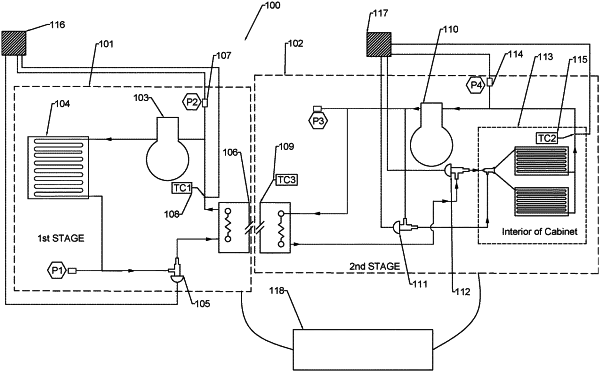| CPC F25B 47/022 (2013.01) [F25B 7/00 (2013.01); F25B 2600/0251 (2013.01); F25B 2600/2507 (2013.01); F25B 2600/2513 (2013.01); F25B 2700/1933 (2013.01); F25B 2700/2103 (2013.01); F25B 2700/21151 (2013.01)] | 21 Claims |

|
1. A multistage, cascade refrigeration system comprising:
a first stage and a second stage thermally connected via a central heat exchanger, the first stage including a first stage liquid expansion valve and a first stage compressor, and the second stage including a second stage liquid expansion valve, a second stage hot gas valve, and a second stage compressor; and
a controller operably coupled to the first and second stage compressors, the first and second stage expansion liquid valves, and the second stage hot gas valve, the controller configured to:
operate the multistage, cascade refrigeration system in a hot gas defrost cycle,
shut off the first stage compressor during at least a portion of the hot gas defrost cycle,
fully close the first and second stage liquid expansion valves during at least a portion of the hot gas defrost cycle, and
open the second stage hot gas valve during the hot gas defrost cycle.
|
|
11. A multistage, cascade refrigeration system comprising:
a first stage and a second stage thermally connected via a central heat exchanger, the first stage including a first stage liquid expansion valve and a first stage compressor, and the second stage including a second stage liquid expansion valve, a second stage hot gas valve, and a second stage compressor;
a temperature sensing device configured to monitor a temperature associated with the central heat exchanger;
a pressure sensing device configured to monitor a suction pressure of a refrigerant associated with the first stage compressor; and
a controller operably coupled to the first and second stage compressors, the first and second stage expansion liquid valves, the temperature sensing device, the pressure sensing device, and the second stage hot gas valve, the controller configured to:
operate the multistage, cascade refrigeration system in a hot gas defrost cycle,
receive an indication of the temperature associated with the central heat exchanger from the temperature sensing device,
receive an indication of the suction pressure of the refrigerant associated with the first stage compressor from the pressure sensing device,
control the first stage liquid expansion valve when the hot gas defrost cycle is initiated to allow the suction pressure of the refrigerant associated with the first stage compressor to equalize and close the first stage liquid expansion valve when a target pressure is reached, and
open the second stage hot gas valve during the hot gas defrost cycle.
|
|
17. An improved method for a hot gas defrost cycle for a multistage, cascade refrigeration system, the multistage, cascade refrigeration system comprising a first stage and a second stage thermally connected via a central heat exchanger, and the improved method comprising:
operating the multistage, cascade system in a hot gas defrost cycle, the hot gas defrost cycle configured to remove ice build-up on a second stage evaporator coil while maintaining air configured to flow across the second stage evaporator coil below the freezing point of water;
shutting off a first stage compressor during at least a portion of the hot gas defrost cycle, the first stage compressor configured to circulate refrigerant within the first stage;
fully closing a first stage liquid expansion valve and a second stage liquid expansion valve during at least a portion of the hot gas defrost cycle, the first stage liquid expansion valve coupled to the first stage and configured to control the flow of refrigerant within the first stage, and the second stage liquid expansion valve coupled to the second stage and configured to control the flow of refrigerant within the second stage; and
opening a second stage hot gas valve during the hot gas defrost cycle, the second stage hot gas valve configured to control the flow of a superheated vapor from the second stage compressor to the second stage evaporator coil enclosure during the hot gas defrost cycle.
|